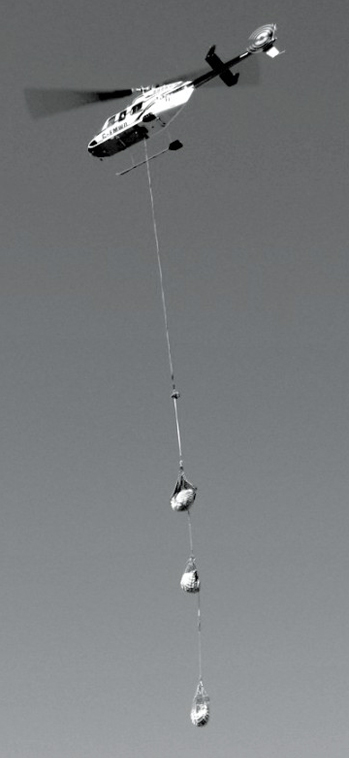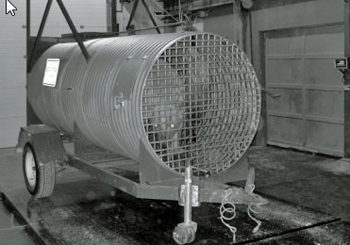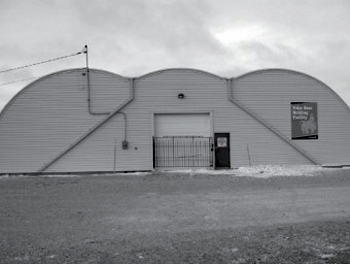by Bob Windsor, Manitoba Conservation

Polar bears that get too close are often housed before being relocated. Photo courtesy of Bob Wendt.
This story originally appeared in Fur Harvester Magazine and is reprinted here courtesy of author Bob Windsor.
Churchill Manitoba is known as the Polar Bear Capital of the World, and rightfully so. Manitoba is home to some of the approximately 1,000 polar bears of the Western Hudson Bay sub-population, and people from all corners of the world flock to Churchill for an opportunity to see the great white bears.
Churchill is built on the bear’s natural migration path, and as a result, it’s not uncommon to see polar bears in the community or skirting along the nearby Hudson Bay Coast. The people of Churchill have learned to co-exist with the bears and have had success in doing it to a degree not found anywhere else in the world.
But it wasn’t always this way. In the late 1960s, the number of bears waiting for Hudson Bay to freeze around Churchill in the fall was as high as 80, and up to 40 bears at a time could be seen in the local waste disposal grounds.
At that time, polar bears posing a threat to human safety or personal property were generally shot. In 1963, 1966 and 1967 there were serious human-bear confrontations in and around the community, and in 1968 there was a fatal attack on a small boy. This led to calls for a program to better manage polar bears in this area.

Three tranquilized polar bears being relocated via helicopter, 70 km north of Churchill.
In 1969, the Polar Bear Control Program was created. The program had three main objectives: to protect human life, to protect personal property from damage by polar bears and to ensure polar bears were not unduly harassed or killed.
During the 1970s there continued to be human-bear encounters, although none were fatal. Persistent and aggressive bears had to be euthanized for the protection of the people, as there was no other way to handle bears that consistently returned to town. An average of 15 polar bears were destroyed each year in the area.
In 1976, 24 problem polar bears were relocated by DC3 airplane from Churchill to the Kaskattama River area, close to the Manitoba-Ontario border on Hudson Bay. This endeavor was very expensive, and some of the bears returned quickly and had to be destroyed.
It was decided that a holding facility for polar bears would moderate the need to euthanize bears. In 1979, construction started on the facility, which was designed to hold 16 single bears and four family groups. The holding pens are built of concrete bricks with steel bar doors and ceilings.
While the facility was under construction, the Polar Bear Alert Program was established in 1980. The priorities of this program include:
- protecting human life from polar bears
- protecting polar bears from harassment or the need to be euthanized
- minimizing damage to property from polar bears
- minimizing the potential of food conditioning and/or human habituation of polar bears
- ensuring the safety of Manitoba Conservation and Water Stewardship staff working with the Polar Bear Alert Program
The Churchill area was divided into three control zones: the living/working area in the community (Zone 1), the inhabited perimeter area (Zone 2) and the remote area (Zone 3). The level of tolerance for the presence of polar bears is lowest in Zone 1, where all bears are immediately removed.
In 1982, the Polar Bear Holding Facility was put into use and it has held over 2,000 bears to date. Most bears captured are housed at the Polar Bear Holding Facility. The facility was upgraded in 2006 and currently has 28 holding pens, five of which have air conditioning for warm weather use. The amount of time each bear spends in the facility varies, and depends on the amount of space available and the location and frequency of capture.
Bears captured in Zone 1 are held for a minimum of 30 days, with the exception of family groups that are relocated as soon as possible. This 30-day rule was to lessen the chance of a polar bear returning to Zone 1, and also prevents the bears from having the opportunity to become conditioned to human food sources.
The bears are provided with water or snow, but are not fed, as polar bears do not normally feed until they are able to hunt for seals on the frozen Hudson Bay, and survive on the fat stores from the previous season. Also, feeding the bears could condition them to associate man with food, which could lead to the bears returning to Churchill in future.
Today’s Polar Bear Alert Program is staffed with two natural resource officers and three resource management technicians with additional staff during the peak season. The program involves public education, minimizing bear attractants and removing bears from a defined area in and around the community.
Staff monitors a 24-hour emergency bear line. Anyone seeing a bear in or near the community can call (204) 675-BEAR and staff will respond. It is not uncommon during the peak period from mid-October to mid-November for staff to be called out five or six times a night. As the weather gets colder and the ice is closer to forming, the bear activity escalates. Just before freeze-up, staff has chased more than a dozen bears along the edge of town in one day.
The removal of bears from the community or an area where they pose a danger is accomplished by hazing. This involves shooting scare cartridges from shotguns or pistols that cause loud bangs or screams, and following the bears with vehicles.
Bears that do not respond to noise stimulus are sometimes shot with rubber bullets (which don’t harm the bear) or a paint ball gun to encourage them on their way. Particularly stubborn bears are sometimes pushed away by helicopter. If a bear continues to return and will not enter a live trap, it will be immobilized with the use of a tranquilizer gun. This is done by either shooting from the ground, or darting the bear from a helicopter.

Polar Bear Culvert Trap
To prevent bears from entering the community, staff will establish a “trap line” around the perimeter of the community to intercept the bears. Bears are captured by use of culvert traps, which are large culverts with metal screens on one end and doors on the other.
The traps are baited with seal meat and fat, which is attached to a trigger in the front of the trap. When the bear enters the trap and pulls on the bait, the door is released and locks. The trap is permanently mounted onto a trailer, which allows the bears to be transported to the Polar Bear Holding Facility.
In 2011, staff responded to 341 polar bear occurrences and handled 61 bears. The most common age class of bears handled is sub-adults (between two- and five-years old).
Each bear is weighed when entering and exiting the Polar Bear Holding Facility, and is measured for length and girth and checked for overall health before it is released.
If not previously handled, each bear will receive ear tags and lip tattoos. The lip tattoo is a number matching their ear tags, and becomes the bear’s permanent “name”. Information such as the date and location of capture, as well as the bear’s health information, is recorded on a data sheet, which is later entered into a data base.
Each year the data base is updated and every bear that has ever been captured will be on record. Many of the bears handled have been tagged previously, some of which have been handled numerous times.
Before freeze-up, bears that are released from the holding facility are tranquilized and then transported by helicopter in a sling approximately 70 kilometers north of Churchill. They are then released along the coast of the Hudson Bay. Most of the bears will continue moving northward looking for the first ice to form.
At the time of release the bears are marked with a green cattle marker spot on the top of their shoulder. This spot allows for easy recognition of released bears during that season, but wears off within a month or two. Very few bears return to Churchill during the same season. Those that do return and are able to be recaptured are held until the end of the season.

The polar bear holding facility in Churchill houses both single bears and family groups until they are ready for relocation.
After ice forms on the Hudson Bay, the remaining bears in the facility are released directly onto the ice of Hudson Bay by vehicle. The bears are loaded into culvert traps and hauled to the coastline and released. When the bears see the ice they are more than happy to get out on it, and to start hunting for seals.
The Polar Bear Alert Program is unique, and receives a large number of media and group presentation requests each year. Requests are accommodated as time permits, with the priority given to those that promote public education.
The most publicized and dramatized night of the entire bear season is Halloween. The safety of children trick or treating is a very real priority, and warrants special preparations. A helicopter patrol is done before dark and any bears found near town are hazed away. At least 12 two-person units are established from various agencies including Manitoba Conservation and Water Stewardship, R.C.M.P., Parks Canada, Canadian Rangers, the fire department, emergency medical services and Manitoba Hydro.
Some units take up strategic vantage positions while others form mobile patrols. Several media film crews and numerous photographers roam around the community to record the event. Experience has proven the best way to avoid any “tricks” is to carry a good supply of “treats” to share from your patrol vehicle.
The staff who administer the Polar Bear Alert Program in Churchill are fortunate to experience the privilege of working with these magnificent predators. Nowhere else in Manitoba offers the unique experiences that the staff in Churchill come to enjoy.
The Polar Bear Alert Program is recognized globally for its achievements in protecting human life and preserving the lives of polar bears. The number of bears euthanized in protection of life or property is, on average, less than one per year. Thanks must be given to the people of Churchill, whose cooperation makes this unique program such a success.








